 W
WAlcotán-100 is a recoilless, one-man portable, single-use anti-tank rocket launcher used by infantry, manufactured by Instalaza. It is in service with the Spanish Military, where it is gradually replacing the C-90.
 W
WThe RAC 112 APILAS, commonly designated APILAS, is a portable one-shot 112 mm recoilless anti-tank weapon, designed in France by GIAT Industries. Over 120,000 of the APILAS launchers have been produced, and they are in service with many countries.
 W
WThe B-300 is a reusable man-portable anti-tank weapon system developed by Israel Military Industries in the late 1970s for use by the Israel Defense Forces. The B-300 can be carried and operated by a single operator and is effective to approximately 400 meters (1,312 ft). Pre-packaged munitions and simple operating mechanisms make the weapon quite versatile, permitting use by airborne, motorized, and ground troops alike. When defence publications first heard reports of the B-300 in the early 1980s, various reports stated in error that it was an Israeli improved and manufactured version of the Russian RPG-7.
 W
WThe backblast area is a cone-shaped area behind a rocket launcher, rocket-assisted takeoff unit or recoilless rifle, where hot gases are expelled when the rocket or rifle is discharged. The backblast area is dangerous to ground personnel, who may be burned by the gases or exposed to overpressure caused by the explosion. In confined spaces, common in urban warfare, even the operators themselves may be at risk due to deflection of backblast by walls or sturdier civilian vehicles behind them.
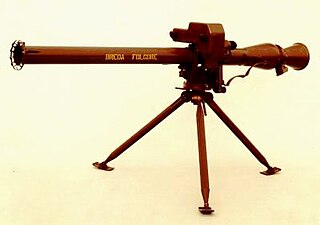 W
WThe Folgore (Thunderbolt) is an Italian 80 mm recoilless anti-tank weapon developed and manufactured by Breda Meccanica Bresciana. It weighs 18.9 kilograms and 25.6 kilograms. Development of the Folgore started in 1974 and it was adopted by the Italian Army in 1986. Over 800 Folgores had been produced by 2001.
 W
WThe Instalaza C90 is a 90 mm disposable, shoulder-fired and one-man operated rocket-propelled grenade launcher (RPG) which can be fitted with a VN38-C night vision device for full night combat capability. It is being used as an infantry-type weapon.
 W
WThe Kestrel is an individual shoulder-launched weapon system developed by Taiwan's National Chung-Shan Institute of Science and Technology and currently in service with the Republic of China Armed Forces and Coast Guard Administration.
 W
WThe LAW 80, sometimes erroneously referred to as LAW 94, is a man-portable, disposable anti-tank weapon currently in use by the British Army and a few other militaries.
 W
WThe LRAC F1, officially called Lance-Roquettes AntiChar de 89 mm modèle F1 is a French reusable rocket launcher developed by Luchaire Défense SA, and manufactured in cooperation with Manufacture Nationale d'Armes de Saint-Étienne and was in the 1970s marketed by Hotchkiss-Brandt.
 W
WThe M80 Zolja is a portable one-shot disposable 64 mm unguided anti-tank rocket-propelled grenade, designed in the former Yugoslavia. The M80 Zolja is still produced in Serbia and in North Macedonia.
 W
WThe M72 LAW is a portable one-shot 66-mm unguided anti-tank weapon. The solid rocket propulsion unit was developed in the newly formed Rohm and Haas research laboratory at Redstone Arsenal in 1959, then the full system was designed by Paul V. Choate, Charles B. Weeks, Frank A. Spinale, et al. at the Hesse-Eastern Division of Norris Thermadore. American production of the weapon began by Hesse-Eastern in 1963, and was terminated by 1983; currently it is produced by Nammo Raufoss AS in Norway and their subsidiary Nammo Talley, Inc. in Arizona.
 W
WThe M79 Osa is a Yugoslav-made portable 90 mm anti-tank weapon made of fibre-reinforced plastics. It resembles the French portable anti-tank launcher 89 mm LRAC F1. It consists of the launcher, a CN-6 sighting piece, rocket and carrying case for the rocket. The M79 shoots unguided projectiles in direct sight and is effective against armoured fighting vehicles and fortifications.
 W
WThe RBR-120 mm M90 is a light-weight, single-use, unguided anti-tank rocket launcher. The launcher is produced by Eurokompozit of Prilep, North Macedonia and Poliester Grupa Priboj Serbia, while the anti-tank rocket is produced by Sloboda Čačak, Serbia. It is intended for use against tanks and other armored vehicles in addition to fortifications and infantry.
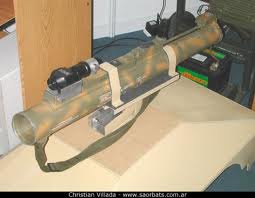 W
WThe MARA is a portable one-shot 78 mm unguided anti-tank weapon, designed and manufactured in Argentina by Fabricaciones Militares (DGFM). The solid rocket propulsion unit was developed by CITEFA.
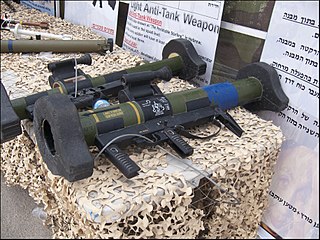 W
WThe MATADOR is a 90-millimetre (3.5 in) man-portable, disposable anti-armor weapon system developed in collaboration between Israel and Singapore. It is an updated version of the German-Singaporean Armbrust design, and operates on the same principles. The development of this weapon began in 2000 and the MATADOR will eventually replace the German-Singaporean Armbrust Light Anti-tank Weapon, which has been in service since the 1980s.
 W
WThe Miniman is a disposable single-shot 74-mm unguided anti-tank smooth bore recoilless weapon, designed in Sweden by Försvarets Fabriksverk (FFV) and became operational in 1968. The Miniman is delivered with the HEAT projectile pre-loaded launch tube. In appearance, the Miniman is similar to a single section tube US M72 LAW and French Sarpac of the same era. In 1986 the Swedish Army adopted the FFV AT4, designated the Pansarskott m/86, to replace the Miniman. FFV engineers adopted the rugged but simple firing and safety mechanism of the Miniman for the AT4. The Miniman uses a unique version of the high-low chamber launch system that results in no recoil.
 W
WPanzerblitz is a German anti-tank unguided aerial rocket developed during the Second World War.
 W
WThe Panzerfaust 3 is a modern disposable recoilless anti-tank weapon, which was developed between 1978 and 1985 and put into service by the Bundeswehr in 1992. It was first ordered in 1973 to provide West German infantry with an effective weapon against contemporary Soviet armour, thereby replacing West Germany's aging PzF 44 Light Lanze launchers and the heavy Carl Gustaf 84 mm anti-tank recoilless rifle manufactured in Sweden. The Panzerfaust 3 is operated by at least 11 countries and has first seen combat in Afghanistan.
 W
WPanzerschreck was the popular name for the Raketenpanzerbüchse 54, an 88 mm reusable anti-tank rocket launcher developed by Nazi Germany in World War II. Another earlier, official common name was Ofenrohr.
 W
WThe Type 98 (PF-98) is a 120mm unguided anti-tank rocket system developed by Norinco for the People's Liberation Army as a successor to the Type 65 and Type 78 recoilless guns. It is also known by its nickname, "Queen Bee".
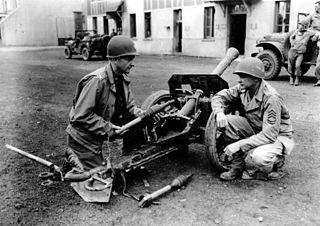 W
WThe 8.8 cm Raketenwerfer 43 Puppchen was an 88 mm calibre reusable anti-tank rocket launcher developed by Nazi Germany during World War II.
 W
WThe RL-83 Blindicide is primarily an antitank rocket launcher, but other rockets can be fired. It was produced by Mecar SA of Belgium and was an improved derivative of the M20A1 Bazooka. Its name translates to "armor killer", derived from the French "blindé" and the suffix -cide meaning to kill.
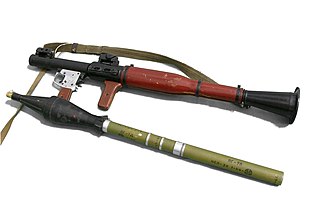 W
WA rocket-propelled grenade is a shoulder-fired missile weapon that launches rockets equipped with an explosive warhead. Most RPGs can be carried by an individual soldier, and are frequently used as anti-tank weapons. These warheads are affixed to a rocket motor which propels the RPG towards the target and they are stabilized in flight with fins. Some types of RPG are reloadable with new rocket-propelled grenades, while others are single-use. RPGs are generally loaded from the front.
 W
WCirit is a laser-guided 70 mm missile system under production by Turkish arms industry manufacturer ROKETSAN. It is one of the projects launched by Turkey to equip the Turkish Army's T-129 Atak, AH-1P Cobra and AH-1W Super Cobra attack helicopters with low-cost precision strike capabilities. It has been selected by Eurocopter for execution of a test and integration program to equip the Eurocopter EC635. The weapon's name comes from a traditional Turkish horseback game, Cirit, where two teams of riders fight a mock battle using wooden javelins which are called cirit.
 W
WThe RPG-28 Klyukva ("Cranberry") is a Russian handheld anti-tank rocket launcher.
 W
WThe RPG-29 "Vampir" is a Soviet reusable rocket-propelled grenade (RPG) launcher. Adopted by the Soviet Army in 1989, it was the last RPG to be adopted by the Soviet military before the fall of the Soviet Union in 1991.
 W
WThe RPG-30 "Kryuk" is a Russian hand-held disposable anti-tank grenade launcher.
 W
WThe RPG-75 is a portable, disposable, single-shot anti-tank weapon, developed in the 1970s in Czechoslovakia. It fires a 68 mm grenade with an effective range of 300 meters and maximum range of 1000 meters. It resembles the American M72 LAW rocket launcher. This RPG is recommended to be used on light tanks and armoured track vehicles.
 W
WThe Type 4 70 mm AT Rocket Launcher was a Japanese rocket launcher used during the last year of World War II. It was to be used in the Japanese mainland in case of an invasion by the Allies.